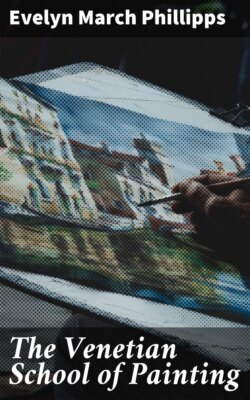Читать книгу The Venetian School of Painting - Evelyn March Phillipps - Страница 14
На сайте Литреса книга снята с продажи.
CHAPTER VII
ОглавлениеTable of Contents
CARLO CRIVELLI
We must turn aside from the main stream when we come to speak of Carlo Crivelli, who, important master as he was, occupies a place by himself. A pupil of the Vivarini and perhaps, as we have noted, of Antonio Negroponte, Crivelli was profoundly influenced by the Paduans, from whom he learned that metallic, finished quality of paint which he carried to perfection. Crivelli shows intellect, individuality, even genius, in the way in which he grapples with his medium and produces his own reading, and the circumstances of his life were such as to throw him in upon himself and to preserve his originality. His little early “Madonna and Child” at Verona is linked with that of Negroponte by the elaborate festoons, strings of beads, and large-patterned brocades used in the surroundings, and has those ugly, foreshortened little putti, holding the instruments of the Passion, of the type elaborated by Squarcione and Marco Zoppo, and which, in their improved state, we are accustomed to think of as Mantegnesque.
When Crivelli was thirty-eight years old, he was condemned to six months’ imprisonment and to a fine of two hundred lire for an outrage on a neighbour’s wife. Perhaps it was to escape from an unenviable reputation that he left Venice soon after and set up painting in the Marches, where he lived from 1468 to 1473. He then went on to Camerino in Umbria, where his great triptych, now in the Brera, was painted, and a few years later he was in Ascoli, with a commission for an Annunciation in the Cathedral. This is the picture now in the National Gallery, in which the Bishop holds a model of the Duomo. After 1490 he worked in little towns in the Marches, and is not mentioned after 1493. He does not seem ever to have come back to Venice.
Shut up in the Marches, where there was little strong local talent, and where he could not keep up with the progress that was taking place in Venice, he was obliged himself to supply the artistic movement. He kept the Squarcionesque traditions to the end, but moulded them by his own love of rich and exuberant decoration. Moreover, he was of a very intense religious bias, and this finds a deeply touching and mystical expression, more especially in his Pietàs. The love of gilded patterns and fanciful detail was deep-seated in all the Umbrian country. His altarpieces were intended as sumptuous additions to rich churches, and were consequently arranged, with many divisions, in the old Muranese manner. His great ancona, in the National Gallery, is a marvel of elaborate ornament and enamel-like painting. The Madonna is delicate, almost affected in her refinement. Her long fingers hold the Child’s garment with the extreme of dainty precision, the croziers and rings of the saints and bishops are embossed with gold and real jewels. The flowers in the panel of “The Immaculate Conception,” which hangs beside it, are twisted into heads of mythological beasts and grotesques or cherubs; but Crivelli has plenty of strength, and his male saints have vigorous, bony limbs and fierce fanatical eyes. It is, however, in his colour that he charms us most, and though he does not touch the real fount, he is of all the earlier school the most remarkable for subtle tender tones and lovely harmonies of olive-greens and faded rose and cream embossed with gold.
Crivelli continued executing one great ancona after another, limiting his progress to perfecting his technique, and his influence was most deeply felt by such Umbrian painters as Lorenzo di San Severino and Niccola Alunno. The honours paid him testify to the reputation he acquired. He was created a knight and presented with a golden laurel wreath. But though he never, that we can hear of, revisited his native State, he always adds Venetus to the signature on his paintings, a fact which tells us that far from Venice and in provincial districts, her prestige was felt and gave his work an enhanced commercial value. He had no after-influence upon the Venetian School, and in this respect is interesting as an example of the tenacity exercised by the Squarcionesque methods, when, unchecked by any counter-attraction, they came to act upon a very different temperament; for in his love of grace and beauty and of rich effects, and especially in his intensity of mystic feeling, Crivelli is a true Venetian and has no natural affinity with the classic spirit of the Paduans.
PRINCIPAL WORKS
| Venice. | SS. Jerome and Augustine. |
| Ascoli. | Duomo: Altarpiece and Pietà. |
| Berlin. | Madonna and six Saints. |
| London. | Pietà; The Blessed Ferretti; Madonna and Saints; Annunciation; Ancona in thirteen compartments; The Immaculate Conception. |
| Mr. Benson: Madonna. | |
| Sir Francis Cook: Madonna enthroned. | |
| Mond Collection: SS. Peter and Paul. | |
| Lord Northbrook: Madonna; Resurrection; Saints; Crucifixion; Madonna; Madonna and Saints. | |
| Milan. | Brera: SS. James, Bernardino, and Pellegrino; SS. Anthony Abbot, Jerome, and Andrew. |
| Poldi-Pezzoli: S. Francis in Adoration. | |
| Rome. | Vatican: Pietà. |
